
Pac-Man, originally called Puck Man in Japan, is a 1980 maze action video game developed and released by Namco for arcades. In North America, the game was released by Midway Manufacturing as part of its licensing agreement with Namco America. The player controls Pac-Man, who must eat all the dots inside an enclosed maze while avoiding four colored ghosts. Eating large flashing dots called "Power Pellets" causes the ghosts to temporarily turn blue, allowing Pac-Man to eat them for bonus points.
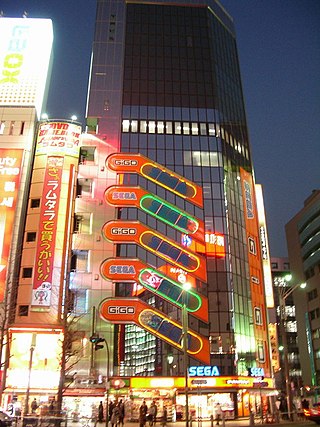
An amusement arcade, also known as a video arcade, amusements, arcade, or penny arcade, is a venue where people play arcade games, including arcade video games, pinball machines, electro-mechanical games, redemption games, merchandisers, or coin-operated billiards or air hockey tables. In some countries, some types of arcades are also legally permitted to provide gambling machines such as slot machines or pachinko machines. Games are usually housed in cabinets.

Namco Limited was a Japanese multinational video game and entertainment company, headquartered in Ōta, Tokyo. It held several international branches, including Namco America in Santa Clara, California, Namco Europe in London, Namco Taiwan in Kaohsiung, and Shanghai Namco in mainland China.

Ms. Pac-Man is a 1982 maze arcade video game developed by General Computer Corporation and published by Midway. It is the first sequel to Pac-Man (1980) and the first entry in the series to not be made by Namco. Controlling the title character, Pac-Man's wife, the player is tasked with eating all of the pellets in an enclosed maze while avoiding four colored ghosts. Eating the larger "power pellets" lets the player eat the ghosts, who turn blue and flee.

Dig Dug is a maze arcade video game developed by Namco in 1981 and released in 1982, distributed in North America by Atari, Inc. The player controls Dig Dug to defeat all enemies per stage, by either inflating them to bursting or crushing them underneath rocks.
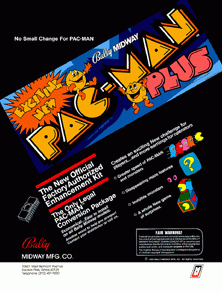
Pac-Man Plus is an arcade game that was released by Bally Midway in 1983. It is part of the Pac-Man series of games.
Redemption games are typically arcade games of skill that reward the player proportionally to their score in the game. The reward most often comes in the form of tickets, with more tickets being awarded for higher scores. These tickets can then be redeemed at a central location for prizes. The most inexpensive prizes may require only a small number of tickets to acquire, while the most expensive ones may require several thousand. In general, the amount of money spent to win enough tickets for a given prize will exceed the value of the prize itself. Some redemption games, such as Flamin' Finger, involve elements of chance, which can be set by the operator.
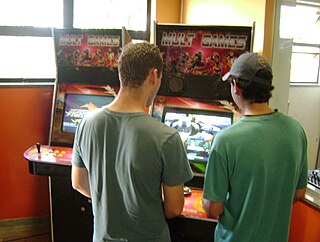
An arcade cabinet, also known as an arcade machine or a coin-op cabinet or coin-op machine, is the housing within which an arcade game's electronic hardware resides. Most cabinets designed since the mid-1980s conform to the Japanese Amusement Machine Manufacturers Association (JAMMA) wiring standard. Some include additional connectors for features not included in the standard.

Rally-X is a maze chase arcade video game developed in Japan and Germany by Namco and released in 1980. In North America, it was distributed by Midway Manufacturing and in Europe by Karateco. Players drive a blue Formula One race car through a multidirectional scrolling maze to collect yellow flags. Boulders block some paths and must be avoided. Red enemy cars pursue the player in an attempt to collide with them. Red cars can be temporarily stunned by laying down smoke screens at the cost of fuel. Rally-X is one of the first games with bonus stages and continuously-playing background music.
Point Blank, known as Gun Bullet, or Gunvari in Japan, is a series of light gun shooter games developed by Namco for the arcade, PlayStation and Nintendo DS; the trilogy was first released in arcade in 1994 and was later ported onto the PlayStation. Point Blank DS was released in 2006 for the Nintendo DS featuring 40 challenges from the original series.
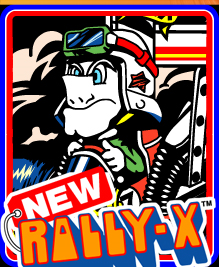
New Rally-X is a maze chase arcade video game released by Namco in 1981. It is a lightly tweaked version of 1980's Rally-X, with slightly enhanced graphics, easier gameplay, a new soundtrack, and a "Lucky Flag" that gives the player extra points for remaining fuel when collected.
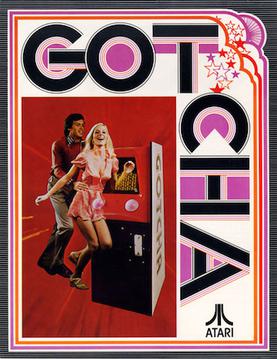
Gotcha is an arcade video game developed by Atari and released in October 1973. It was the fourth game by the company, after the 1972 Pong, which marked the beginning of the commercial video game industry along with the Magnavox Odyssey, and the 1973 Space Race and Pong Doubles. In the game, two players move through a maze, which continually changes over time. One player, the Pursuer, attempts to catch the other, the Pursued; if they do, a point is scored, and the players reset positions. The game emits an electronic beeping sound, which increases in pace as the Pursuer gets closer to the Pursued, and each game lasts a set amount of time.
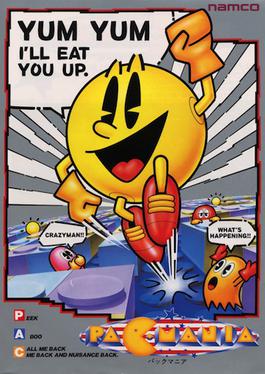
Pac-Mania is a cavalier perspective maze game that was developed and released by Namco for arcades in 1987. In the game, the player controls Pac-Man as he must eat all of the dots while avoiding the colored ghosts that chase him in the maze. Eating large flashing "Power Pellets" will allow Pac-Man to eat the ghosts for bonus points, which lasts for a short period of time. A new feature to this game allows Pac-Man to jump over the ghosts to evade capture. It is the ninth title in the Pac-Man video game series and was the last one developed for arcades up until the release of Pac-Man Arrangement in 1996. Development was directed by Pac-Man creator Toru Iwatani. It was licensed to Atari Games for release in North America.
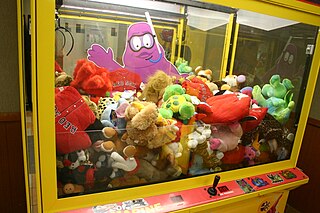
A merchandiser is a type of arcade gaming device, which features a machine that contains a display of merchandise, which can be won by playing the game. In the trade, such games are described as "skill with prize" (SWP) games, and are a hybrid of games of skill and games of chance, with the preponderance of skill or chance differing between devices and often able to be set by the operator.
A 'Skill with Prize' (SWP) machine is a gaming device that awards payouts based on a combination of the player's skill and elements of chance. This category of gaming machine is distinct from 'Amusement with Prize' (AWP) machines, which are interactive but primarily rely on chance rather than skill to determine the game's outcome. SWP machines incorporate elements of both skill-based and chance-based gaming. The degree to which skill and chance influence the outcome can differ significantly among machines and may be modified by the operator to adjust the balance between the two.

Tekken Tag Tournament 2 is the eighth installment in the Tekken fighting game series and the sequel to Tekken Tag Tournament. It was released for the arcades in September 2011. It received an update, subtitled Unlimited, in March 2012. A console version based on the update was released for PlayStation 3 and Xbox 360 in September 2012, prior to the update. It was ported to the Wii U as one of the system's launch titles in November 2012, subtitled Wii U Edition.
Non-redemption is the term used by family fun centers and arcades to indicate that a particular game or attraction does not give out tickets for prizes, as opposed to a redemption game.

Pac-Man Championship Edition 2 is a maze arcade game in the Pac-Man series which was released for PlayStation 4, Windows, and Xbox One on September 15, 2016; an updated version featuring an exclusive 2-player co-op mode, Pac-Man Championship Edition 2 Plus, was released for Nintendo Switch on February 22, 2018. It was developed and published by Bandai Namco Entertainment, and is a direct sequel to Pac-Man Championship Edition, making it an indirect follow-up of Pac-Man Championship Edition DX+.

The Pac-Man 40th Anniversary was a celebration of the Pac-Man series of video games since the release of the arcade cabinet Pac-Man on May 22, 1980. Bandai Namco celebrated the anniversary through business ventures with video games, events, clothing and other forms of merchandise. The anniversary took place throughout 2020, and ended in early 2021.

An arcade game or coin-op game is a coin-operated entertainment machine typically installed in public businesses such as restaurants, bars and amusement arcades. Most arcade games are presented as primarily games of skill and include arcade video games, pinball machines, electro-mechanical games, redemption games or merchandisers.















